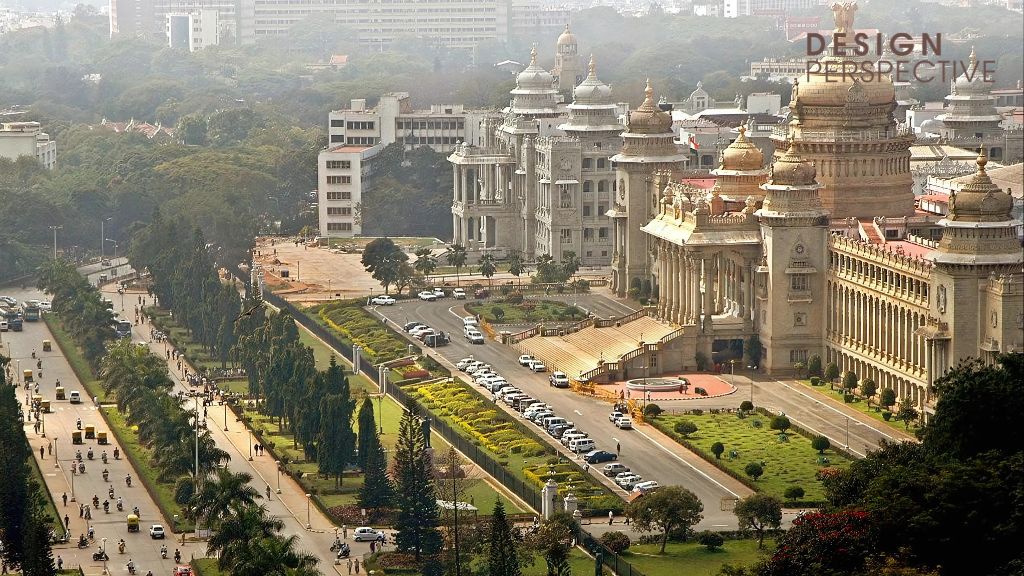Bengaluru isn’t just a city you visit — it’s a city you feel. Every street, every building, every park holds a piece of its story. Over the years, it has layered colonial history, local resilience, creative reuse of spaces, and a love for urban greenery into its very fabric. Every landmark here has a story — some full of celebration, others asking for reflection — but all shaped by thoughtful design and a spirit that’s uniquely Bengaluru.
If you’re an architect, designer, or urbanist, these six spaces aren’t just easy on the eyes — they tell the story of how Bengaluru keeps evolving
Lalbagh Botanical Garden – A Living Legacy in Landscape Architecture

Commissioned by Hyder Ali in the 18th century and later developed by Tipu Sultan, Lalbagh Botanical Garden stands as a timeless example of curated ecology and formal garden design. It features India’s first glasshouse, inspired by London’s Crystal Palace, and hosts rare flora sourced globally.Beyond its visual appeal, Lalbagh showcases Mughal-inspired symmetry, axial pathways, and botanical taxonomy, positioning it as a living laboratory of landscape architecture. The garden’s design is a compelling case study for those exploring the relationship between colonial horticulture, cultural legacy, and ecological planning.
Vidhana Soudha – Where Democracy Meets Dravidian Grandeur

An iconic seat of power, Vidhana Soudha exemplifies neo-Dravidian architecture — a style that intentionally merges Indo-Islamic, colonial, and South Indian elements. Designed using native Bangalore granite, the building integrates monumental columns, a massive central dome, and intricate cornices.Its visual language speaks volumes: a symbolic assertion of democratic ideals rooted in regional pride. For architects studying civic identity through built form, Vidhana Soudha is a commanding reference of how architecture shapes collective memory.
Cubbon Park – Urban Planning with Colonial Undertones

Established in 1870 by British engineer R.H. Sankey, Cubbon Park reflects early urban planning ideologies influenced by the colonial administration. The park’s strategic axial design links key civic landmarks like Attara Kacheri and the Museum — a textbook example of spatial alignment in public design.What makes Cubbon Park unique is its synthesis of geometric order with organic landscape elements, offering a nuanced look at how colonial powers used green spaces as tools of social and visual control, while inadvertently creating lasting urban lungs.
Seshadri Iyer Memorial Library – Classical Columns in a Canopy of Green

Built in 1913 to honor Sir K. Seshadri Iyer — often referred to as the architect of modern Bangalore — this Tuscan-red structure is a fine example of European classical architecture adapted for India.Located within Cubbon Park, the building uses Tuscan and Corinthian orders in a manner that complements its lush surroundings. It reflects a moment in time when architecture was used to represent not just governance but intellectual prestige. Today, it remains both a literary repository and a visual landmark, highlighting the city’s blend of public learning and civic design.
Freedom Park – Adaptive Reuse with Cultural Resonance

Transformed from the city’s former Central Jail, Freedom Park is a powerful example of adaptive reuse in public space design. Designed by Mathew & Ghosh Architects, the space preserves its historic essence while integrating contemporary civic programming.The project goes beyond aesthetics — it engages with collective memory, public discourse, and layered spatial narratives. The preserved watchtowers, radial layout, and remnants of confinement have been reinterpreted into amphitheatres, open-air galleries, and civic plazas. A compelling model of how architecture can reclaim and reinterpret trauma into community resilience.
Bangalore Palace – Tudor Grandeur in Indian Soil

Constructed in 1878 and inspired by Windsor Castle, Bangalore Palace represents Tudor-style architecture fused with Indian craftsmanship. Fortified towers, Gothic windows, and opulent interiors echo a unique narrative — one of cultural borrowing, colonial aspiration, and regional reinterpretation.
The palace isn’t just a heritage attraction — it’s a built statement of how architecture was used to navigate identity, power, and legacy. Its presence in modern Bangalore acts as a bridge between the city’s regal past and its contemporary urban ethos.
Design Perspective – The Bengaluru Edition

Bengaluru’s design journey is anything but linear, from botanical layouts to brutal civic symbols. It oscillates between preservation and progress, control and creativity, colonial geometry and native resistance. For architects, designers, and planners, the city offers a rare opportunity to study how spatial narratives evolve across centuries — and how every stone, arch, and axis is layered with meaning. This is Bangalore through a design lens — not just to be seen, but to be interpreted.
Register now for Design Perspective – Bengaluru Edition

